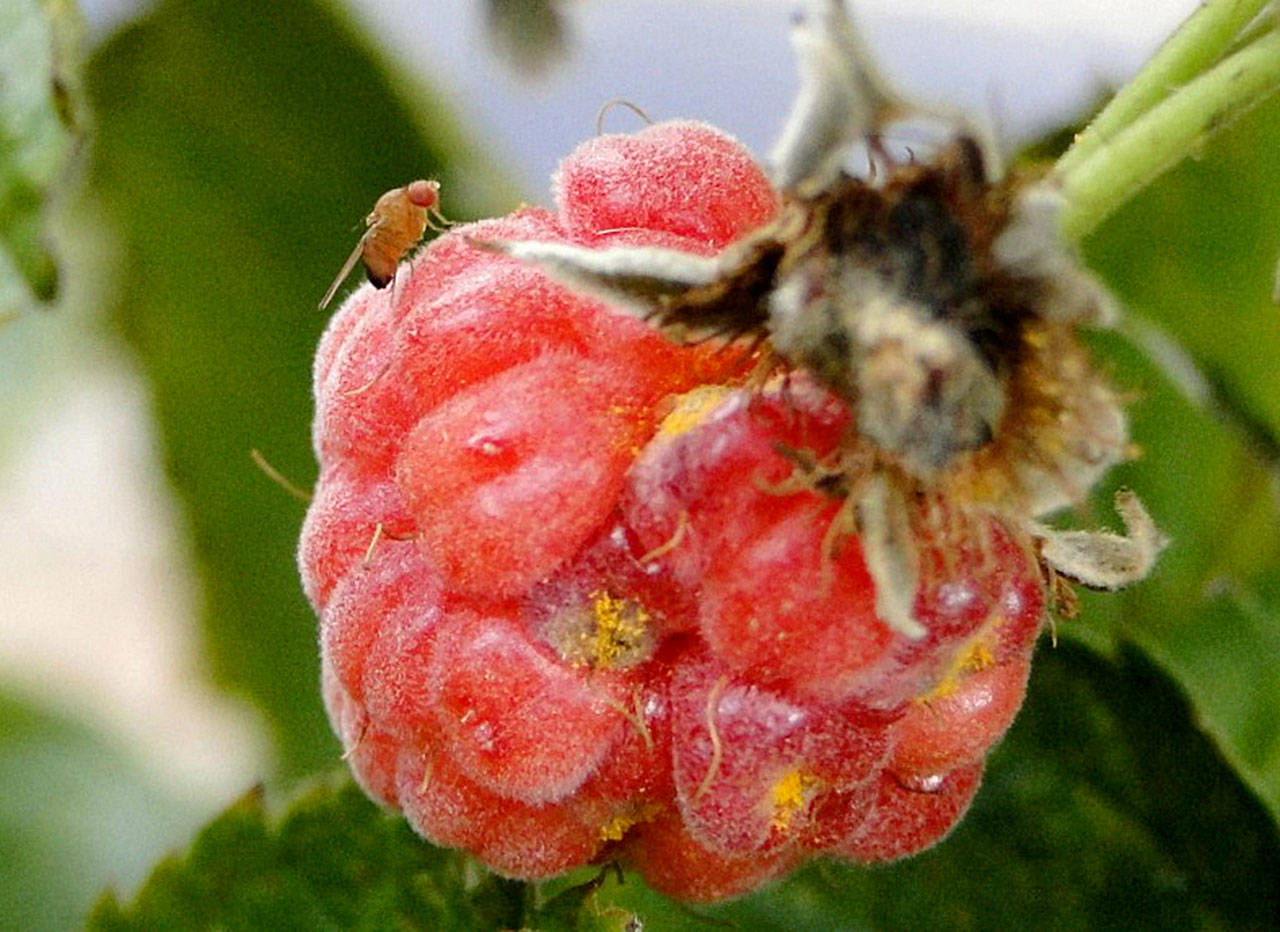At less than an eighth of an inch in length — a pint-sized pest by most standards— the spotted wing drosophila (SWD) can be a huge problem in berry patches and orchards.
SWD (scientific name: Drosophila suzukii) is a type of fruit fly, or vinegar fly. It looks and acts a lot like the common fruit fly (D. melanogaster), a nuisance pest that buzzes around the kitchen and lays its eggs in damaged and rotting fruit.
SWD, however, differs from the common fruit fly in two significant ways.
Adult males have a single spot on the leading edge of each wing (from which the species gets its common name) and
Adult females have a saw-like egg-laying organ (ovipositor).
This latter difference allows SWD to lay eggs in undamaged fruit that is still on the plant, making it much more than a nuisance.
Spotted wing drosophila can destroy a harvest as it lays its eggs in thin-skinned fruits and berries (including blackberries, blueberries, cherries, currants, figs, grapes, kiwi, plums, raspberries and strawberries) that are just beginning to ripen
Life cycle
Adult SWD females start laying eggs in the late spring/early summer as fruit begins to ripen. When laying eggs, the female creates a small slit in the fruit skin and inserts as many as three eggs before moving on. A single SWD female can lay on average 350 eggs in her lifetime.
Within a few days, small white- or cream-colored larvae hatch from the eggs and begin feeding. As the larvae feed, the fruit softens and collapses around the feeding site. Further damage can be caused by fungi and bacteria that invade the damaged fruit.
After five to seven days of feeding, the larvae pupate (undergo a quiescent stage of metamorphosis) within the fruit or drop to the ground to pupate. In a week or two, mature adults emerge from the pupa to start the cycle again. Because multiple generations of SWD usually occur in a single growing season, populations increase dramatically through the summer.
As fall arrives and temperatures cool, egg-laying ceases. Adult SWD overwinter by hiding in the skins and husks of decaying fruit and other places.
Prevention, control
Spotted wing drosophila have been reported in many parts of the United States including local gardens. So be on the lookout.
The following steps will help prevent a buildup of SWD in your berry patch or orchard:
• Select thick-skinned cultivars of fruits or varieties that ripen early in the season, before a large numbers of SWD appear. SWD infestations are most problematic for late-season berry crops, including blackberries, fall-bearing raspberries (also known as primocane-bearing raspberries), day-neutral strawberries and late-season blueberries.
• Because SWD adults prefer shady and humid habitats, prune your plants for good air circulation. Fix leaky irrigation lines and avoid overhead watering.
• Protect fruit from egg-laying females by covering host plants with a fine-mesh floating row cover. This tactic is not feasible with taller plants and care must be taken to introduce pollinators into the crop area under the netting.
• Harvest berries frequently to prevent SWD from successfully maturing in the crop. Pick cleanly. Do not let overly ripe fruit remain on the plant.
• Inspect maturing fruit, looking for signs of SWD infestation. At the first signs of an infestation, harvest daily.
• Do not compost infested fruit. Dispose of it in sealed plastic bags. Lay the bags in the sun to kill the larvae or throw them in the trash.
• Cool fruit soon after harvest to slow development of eggs and larvae.
• Remove fruit on the ground which can provide overwintering spots for adult SWD.
• Insecticides are available to help control SWD and are aimed at adult flies. Applications must be carefully timed with the emergence of the adult stage and repeated with successive generations.
• Vinegar traps hung in host plants will attract flies and drown them, but are for monitoring purposes only and will not provide significant control of SWD.
To learn more about this small but formidable garden pest, go to treefruit.wsu.edu/crop-protection/opm/spotted-wing-drosophila.
Jeanette Stehr-Green is a berry enthusiast and WSU-certified Clallam County Master Gardener.
Virtual garden show
Clallam County Master Gardeners are working with the Soroptimist International of Sequim to present some education presentations online for the group’s 22nd-annual Gala Garden Show.
The show was cancelled because of the COVID-19 pandemic in March, so Soroptimists moved the event online. Beginning Aug. 22, the show will feature Muriel Nesbitt with a Zoom presentation about saving seeds.
Go to www.sequimgardenshow.com click on the Facebook link. Instructions will be available on how to register to attend the Zoom presentation.
Community members are encouraged to return on Sept. 13 and participate over the following two weeks in variety of educational forums, Master Gardener expert panel, informational interviews and an online raffle.


